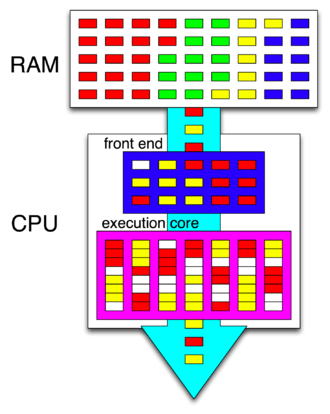
Hyper-threading (officially called Hyper-Threading Technology or HT Technology and abbreviated as HTT or HT) is Intel's proprietary simultaneous multithreading (SMT) implementation used to improve parallelization of computations (doing multiple tasks at once) performed on x86 microprocessors. It was introduced on Xeon server processors in February 2002 and on Pentium 4 desktop processors in November 2002.[4] Since then, Intel has included this technology in Itanium, Atom, and Core 'i' Series CPUs, among others.[5]
For each processor core that is physically present, the operating system addresses two virtual (logical) cores and shares the workload between them when possible. The main function of hyper-threading is to increase the number of independent instructions in the pipeline; it takes advantage of superscalar architecture, in which multiple instructions operate on separate data in parallel. With HTT, one physical core appears as two processors to the operating system, allowing concurrent scheduling of two processes per core. In addition, two or more processes can use the same resources: If resources for one process are not available, then another process can continue if its resources are available.
In addition to requiring simultaneous multithreading support in the operating system, hyper-threading can be properly utilized only with an operating system specifically optimized for it.[6]
- ^ Stokes, Jon (3 October 2002). "Introduction to Multithreading, Superthreading and Hyperthreading". Ars Technica. pp. 2–3. Retrieved 30 September 2015.
- ^ Deborah T. Marr; Frank Binns; David L. Hill; Glenn Hinton; David A. Koufaty; J. Alan Miller; Michael Upton (12 December 2006). "Hyper-Threading Technology Architecture and Microarchitecture" (PDF). cs.sfu.ca. Archived from the original (PDF) on 23 September 2015. Retrieved 30 September 2015.
- ^ Anand Lal Shimpi (5 October 2012). "The Haswell Front End – Intel's Haswell Architecture Analyzed". AnandTech. Retrieved 30 September 2015.
- ^ "Intel Pentium 4 3.06GHz CPU with Hyper-Threading Technology: Killing Two Birds with a Stone." X-bit labs. Archived from the original on 31 May 2014. Retrieved 4 June 2014.
- ^ "Intel® Hyper-Threading Technology (Intel® HT Technology)". Intel. Retrieved 24 October 2021.
- ^ Intel Required Components Interchangeability List for the Intel Pentium 4 Processor with HT Technology, includes list of Operating Systems that include optimizations for Hyper-Threading Technology; they are Windows XP Professional 64, Windows XP MCE, Windows XP Home, Windows XP Professional, some versions of Linux such as COSIX Linux 4.0, RedHat Linux 9 (Professional and Personal versions), RedFlag Linux Desktop 4.0 and SuSe Linux 8.2 (Professional and Personal versions)